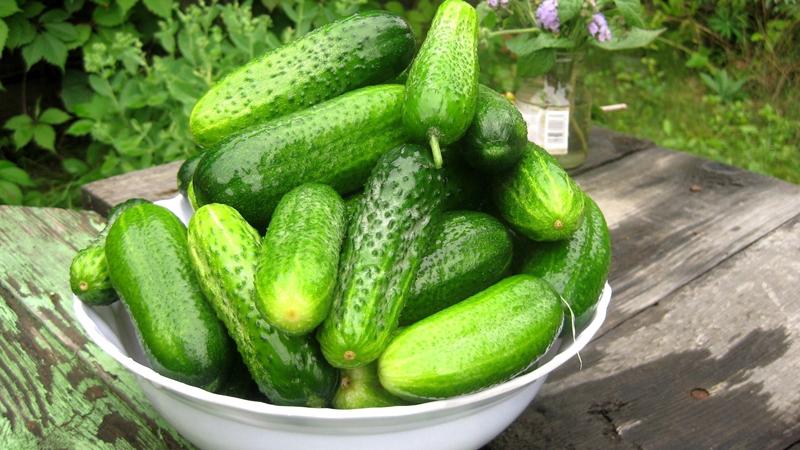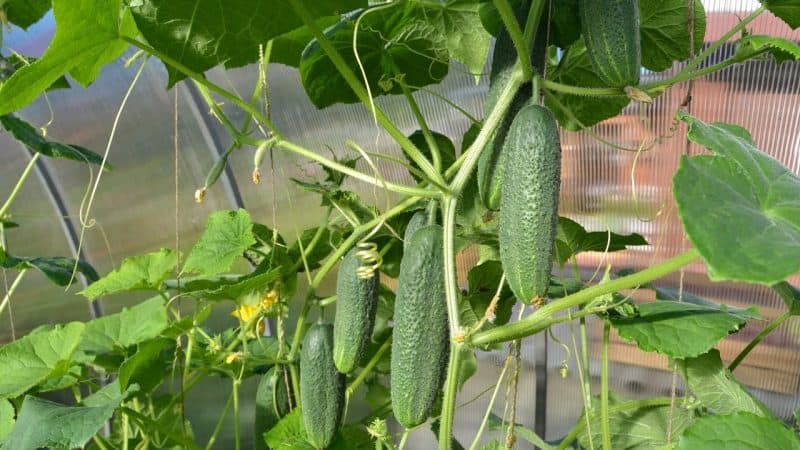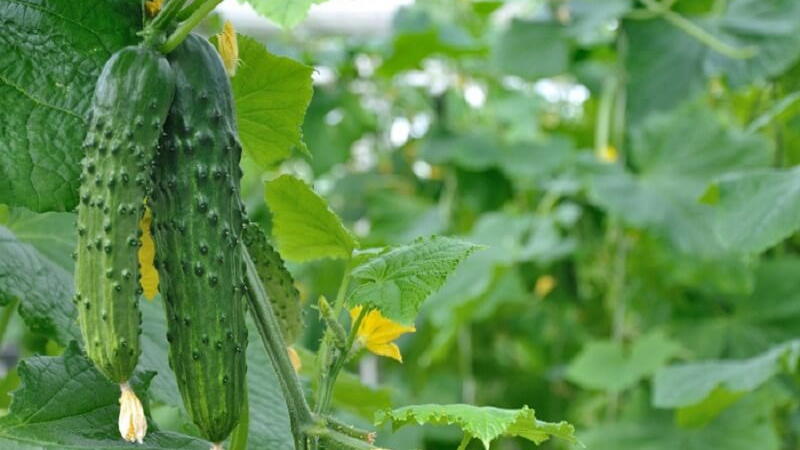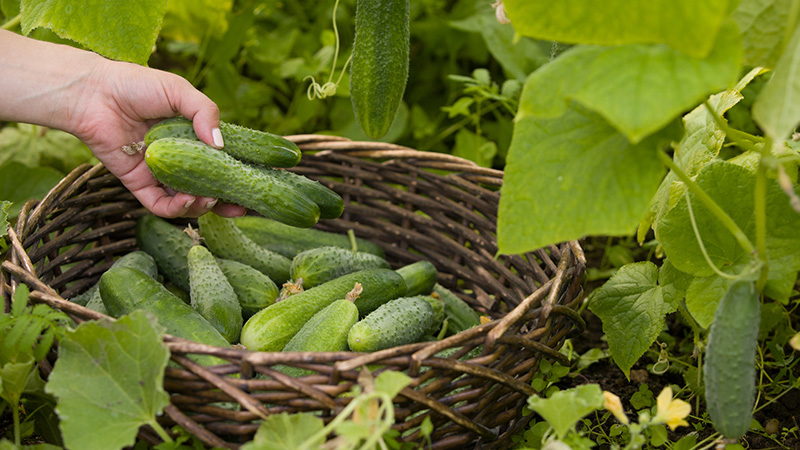Why cucumbers are bitter, how to prevent it, and what to do with a crop that tastes bitter
Cucumbers are a favorite vegetable for children and adults. They are salted, fermented, consumed fresh. Experienced gardeners know that it is not so easy to grow cucumbers, because they need competent care. A common vegetable problem is the bitterness of the fruit.
It is impossible to answer the question why cucumbers are bitter in one word. In this article, we'll explain where bitterness comes from and how to deal with it. You will find out what you can do with such fruits and whether it is worth eating them.
The content of the article
Features of the composition of bitter cucumbers

Cucumbers are native to Southeast Asia. Acceptable habitat for them - rainforests... Vegetables grow in damp places out of direct sunlight. Wild cucumbers have a bitter taste. Modern varieties are bred by selection and do not have bitterness. However, at the genetic level, some of them retained the ability to accumulate it.
Bad weather, sudden changes in temperature, inadequate nutrition are irritating factors for plants. They do not tolerate heat and cold well, react painfully to uneven watering... At such moments, cucumbers turn on the anti-stress mechanism and begin to produce cucurbitacin, a substance that gives bitterness. This taste speaks of the plant's experience of stress.
What gives bitterness
For man bitterness does no harm - in moderate doses, it is even useful.
The effect of bitter cucumbers on the human body:
- improve the functioning of the gastrointestinal tract;
- normalize blood sugar levels;
- have analgesic and anti-inflammatory effects;
- strengthen the heart muscle;
- block the development of cancer cells.
Causes of the Bitter Taste of Cucumbers in the Greenhouse and Outdoors

Why are cucumbers bitter? There are many reasons. To prevent this problem, experienced gardeners take preventive measures before the start of the sowing period. Technologies for growing crops in a greenhouse and open field are similar in many ways, but differ in some features.
The specifics of greenhouse care:
- Due to the lack of fresh air in hot weather, the room must be ventilated.
- Lack of natural moisture can be replaced by irrigating the ceiling and walls with water on hot days.
- In the greenhouse, it is better to use two-row and staggered planting methods.
Features of growing crops in the open field:
- All planting methods can be used.
- To ventilate the plants, the beds are formed from north to south.
- Artificial shading will help to avoid burns from direct sunlight. To do this, near the cucumber garden, they make curtains of corn or build a canopy.
Excess or lack of moisture
The cause of the bitterness of cucumbers is improper watering. Lack and excess of moisture equally negatively affect plants. Before flowering, cucumbers are watered moderately, in a volume of 5 liters per 1 m2 of planting. If the bushes have a lot of foliage and few ovaries, the plants need to be "dried". To do this, skip one watering.
During the flowering of cucumbers and throughout the entire fruiting period, watering is increased to 12 liters per 1 m2. Water it every two days. On hot days, when the demand for moisture increases, the plants are hydrated daily.
Important! Don't forget that cucumbers are liana plants native to the rainforest. Therefore, they love moist soil.
Watering recommendations:
- Prevent the soil from drying out.
- Water at the root and in the aisle.
- Use warm water.
- Try to keep the liquid out of the leaves.
- In hot weather, water every day.
- Moisten the soil a little before flowering.
- Water abundantly during flowering and fruiting.
Advice... Mulch under bushes and between rows. This will keep moisture in the soil.
Exposure to direct sunlight
Cucumbers naturally grow in forests and climb trees, creating a darkening for themselves. Direct sunlight negatively affects the growth and development of cucumber tops. Getting burned, the leaves get sick, and the plant begins to die. In the open ground, cucumbers are planted in the direction from north to south, so that the sun's rays scatter, falling on the garden from all sides. With this arrangement, the plants are evenly illuminated and do not suffer.
Planting density
Positioning vegetables correctly is one step towards a loss-free harvest. Consider the basic schemes for planting cucumbers and the formation of beds. Their choice depends on which varieties will be grown and where they will be located - in a greenhouse or open field.
Landing schemes:
- The double row is suitable for varieties with underdeveloped branches or long fruits. With this method, one bed with two rows is obtained, the distance between which is 50 cm. A gap is made between the beds - a path of 70–90 cm. The seeds are planted at a distance of 30–40 cm from each other.
- Single row suitable for vigorous varieties with long strings. Plants are planted at a distance of 20-30 cm from each other, rows are made every 50-70 cm.
- Staggered. Such a bed is ventilated and illuminated from all sides. The distance between the vegetables is 30 cm. During staggered planting, the cucumber whips do not intersect, the fruits grow freely, it is easy to harvest. 50 cm is left between the rows.
- The circular method is only suitable for growing cucumbers in the open field. A circle with a diameter of 1.5 m is made and grooves are dug at a distance of 30 cm from each other. Compost or humus is placed at the bottom of each, covered with earth and a seed is planted. A large wooden support is placed in the center, to which cucumbers are tied with twine or a thin rope.
Watering with cold water

Even with the same care for all the bushes, some cucumbers turn out to be bitter, while others do not. The reason for this may be improper watering, and specifically - the use of cold water. Cucumbers suffer greatly from it on hot days. When exposed to such moisture, plant roots heated in the sun are stressed, which leads to the production of cucurbitacin, a substance that gives bitterness.
Other factors
Other factors affect the appearance of bitterness:
- Malnutrition. Lack or excess of nitrogen in the soil leads to the production of cucurbitacin. Nitrogen fertilizers begin to be applied after the appearance of the fourth leaf. Before flowering, fertilize twice with an interval of 14 days. During flowering and fruiting, they switch to potash and phosphorus fertilizers.
- Features of culture. This problem is common in hybrids. When buying seeds in the store, pay attention to the presence of the inscription "No bitterness" on the packaging.
- Use for fertilization of horse manure, which releases a lot of ammonia during decomposition. This produces nitrates, which leads to the bitterness of the cucumbers.
What to do
Identifying the cause of cucumber bitterness is the first step towards eliminating it. Start with the right feeding. At the initial stage, nitrogen fertilizers are used, during fruiting - potash fertilizers.
The following dressings will help to get a bountiful harvest of high-quality fruits:
- The first is at the stage of the fourth sheet... Add 2 tbsp to a bucket of water. tablespoons of ammonia. Watered with a solution of half a liter under the bush. This will compensate for the lack of nitrogen and give the growth of green mass.
- Fertilize the second time after 2 weeks. Ammonium nitrate is used for this. Diluted in 10 liters of water 2 tbsp. tablespoons of saltpeter, watered with 0.5 liters under the plant. Fertilizers are applied after moistening the soil.
- Subsequent times - potash or phosphorus fertilization during flowering and fruiting... Fertilize with the following solution: 1 tbsp. spoon of superphosphate, 2 tbsp. tablespoons of potassium phosphate, 0.5 liters of liquid manure. All components are diluted in a bucket of water. Pour half a liter under the bush. The procedure is carried out 2 times per season.
For the prevention of diseases, foliar top dressing is done with a solution of serum with iodine, processing the bushes in the evening. To do this, dilute 1 liter of serum and 3-4 drops of iodine in 10 liters of water.
The following methods will help to achieve a positive result in the fight against bitterness:
- Maintaining humidity levels. This is important for shaping the taste of cucumbers. The air in the greenhouse should be humid, for which the walls and paths are sprayed with water. The greenhouse is regularly ventilated. In the open ground, the aisles are watered.
- Regular and timely watering... At the beginning of growth, irrigation is moderate with an interval of 2-3 days. During flowering and fruiting, watering is increased. Use 1 liter of water per bush. In hot weather, the volume increases, the soil is moistened every day. Irrigate not only the beds, but also the aisles.
- Temperature control. Cold and hot weather have an equally negative effect on plants. To prevent bitterness in the open field, mulch the soil. In the greenhouse, the temperature is regulated as follows: they close the room at night, and ventilate during the day.
- Use of proven planting material. It is recommended to choose seeds without genetic bitterness. For example, to grow hybrids Herman, Santana.
Organic fertilizers such as mullein or bird droppings are used for feeding.
Important! Do not water the cucumbers with cold water.
How to use bitter cucumbers

Having found such fruits, do not rush to throw them away.There are several ways to use them:
- In conservation... Salads for the winter are prepared from such vegetables, their fermented, pickle... During heat treatment, the bitterness disappears.
- In the preparation of masks for skin care. If you regularly wipe your face with cucumber peel, the number of blackheads decreases.
- In the treatment of burns and diaper rash in children and adults.
Bitter fruits can be eaten after peeling them. Soaking in water is also used.
How to prevent cucumber bitterness
Preventing bitterness is easy if you understand the reason why it tastes like this. Competent agricultural technology will help avoid this problem.
Recommended activities:
- soil preparation before planting - the introduction of humus, compost;
- the use of light non-acidic soil (lime is added to deoxidize the soil);
- exclusion of stressful situations: drying out of the soil, watering with cold water, drafts, direct sunlight;
- irrigation regime without excess and lack of moisture;
- ensuring normal lighting and humidity in the greenhouse;
- feeding in accordance with the periods of plant growth;
- selection of a variety without a genetic predisposition to bitterness;
- preservation of soil moisture by mulching the soil with grass, hay, sawdust.
Varieties of non-bitter cucumbers
To choose a vegetable crop that will give non-bitter fruits, it is important to know the following nuances:
- Dark-fruited varieties are more prone to bitterness.
- Long-fruited or salad cucumbers rarely taste bitter. Among them are Athena F1, Angelina F1, Ajax F1, Virenta F1.
- Cucumbers with black spines have a bitter taste.
Advice... Use varieties that are popular in your area.
Conclusion
The cucumbers that we grow in our gardens are obtained by selection from wild plants. In nature, they grew in tropical forests and tasted bitter. The plant is capricious in its care, and the violation of the cultivation technology causes stress in it. Improper watering, lack or excess of nitrogen fertilizers, heat, cold and other negative factors lead to the production of cucurbitacin, a substance that gives bitterness.
By placing the beds from north to south, you will provide plants with ventilation and save them from direct sunlight.Feeding with ammonium nitrate, superphosphate and potassium phosphate will fill the need of cucumbers for these substances. Proper watering without waterlogging and drying out the soil, as well as different planting methods will be the key to success in combating the bitterness of vegetables.